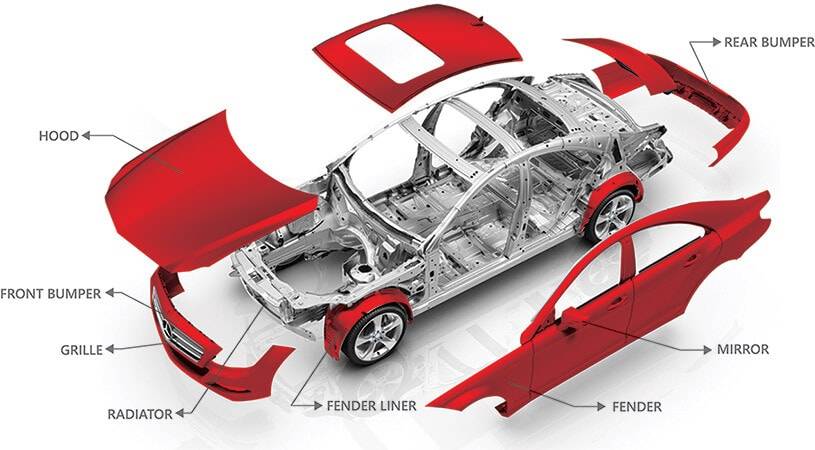

Electrical Components In a Car
The automotive industry has witnessed remarkable technological advancements over the years, transforming cars into sophisticated machines integrated with various electrical components. Modern automobiles are complex machines that rely heavily on electrical systems to function efficiently. Therefore, these crucial components ensure a car’s safety, comfort, and performance.
So, through this article, let’s explore key electrical components found in a typical car.

Battery: The battery is the heart of the electrical system in a car. It provides the initial power to start the engine. It further powers and stabilizes the voltage in the electrical system when the engine is off or not generating sufficient power.

Alternator: Once the engine is running, the alternator powers the electrical system while simultaneously charging the battery. It converts mechanical energy from the engine into electrical energy, replenishing the battery’s charge and supplying power to electrical components.

Starter Motor: The starter motor is essential to initiate the engine’s combustion process. It draws electrical current from the battery to rotate the engine’s crankshaft and start the combustion cycle.

Ignition System: The ignition system consists of various components, including ignition coils, spark plugs, and the ignition control module. It controls the timing and distribution of high-voltage electrical sparks that ignite the fuel-air mixture in the engine’s cylinders. Thus, the ignition system ensures reliable combustion and engine operation.

Engine Control Unit (ECU): The Engine Control Unit, (ECU) is the brain of the electrical system. It is a computerized component that controls different aspects of the engine’s operation. Additionally, it gathers inputs from sensors throughout the vehicle, including those measuring engine temperature, oxygen levels, throttle position, and more. Accordingly, the ECU adjusts fuel injection, ignition timing, and other parameters ensuring optimal engine performance and emissions control.

Sensors:
Modern cars equipped with numerous sensors provide crucial data to the ECU and other control systems. These include the oxygen sensor, temperature sensor, crankshaft position sensor, speed sensor, ABS sensor, and many more. They also monitor various parameters to ensure the engine runs smoothly and efficiently.

Lighting Systems: A car’s lighting system comprises various electrical components that provide illumination inside and outside the vehicle. These include headlights, taillights, turn signals, brake lights, interior lights, and dashboard indicators. These components use bulbs or LED technology controlled by switches and relays. Hence, it is crucial ensuring visibility and safety, especially during low-light conditions or adverse weather.

Power Windows and Locks: Power windows and door locks are standard features in modern cars. These systems utilize electrical motors, switches, and actuators to raise and lower windows and control the locking mechanism of doors. Thus, these components provide convenience and enhance the security of the vehicle.

Fuel Injection System: Modern cars use electronic fuel injection systems to deliver a precise amount of fuel to the engine for combustion. It also includes fuel injectors, a fuel pump, and a fuel pressure regulator. The system is electronically controlled and works in sync with the ECU to achieve efficient fuel combustion and power delivery.

Audio and Entertainment Systems: Car audio systems have become increasingly sophisticated over the years providing audio entertainment and enhancing the driving experience. These include the radio, speakers, and amplifiers, which rely on electrical components to produce sound. It is further connected to the car’s electrical system with additional features like Bluetooth connectivity, navigation systems, USB ports, and touchscreen displays.

Climate Control System: The climate control system regulates the temperature and airflow inside the car. It includes an air conditioning system, heater, blower motor, and various sensors. Moreover, these electrical components work together to provide comfort and maintain the desired cabin temperature.

Safety Systems: Electrical components are also crucial in ensuring the safety of occupants (driver and passengers). These include the anti-lock braking system (ABS), traction control system (TCS), electronic stability control (ESC), tire pressure monitoring systems (TPMS), collision avoidance systems, airbag control modules, and seat-belt pretension. Moreover, these systems use sensors, actuators, and control modules to detect and respond to potentially dangerous situations, enhancing vehicle safety.

Instrument Cluster: The instrument cluster or dashboard displays essential information to the driver, including speed, fuel level, engine temperature, and warning lights. Moreover, modern instrument clusters often incorporate digital screens and advanced graphical displays.

Parking Assistance Systems: Also, many modern cars are equipped with parking assistance systems, such as parking sensors and rear-view cameras. These rely on electrical components to detect obstacles and provide visual or audible feedback to the driver, assisting in parking maneuvers.
Conclusion
From ignition to entertainment systems, electrical components have become the nerve system of modern automobiles, revolutionizing the way cars operate. Their integration has significantly enhanced vehicle safety, performance, and comfort thereby providing a seamless driving experience. As automotive technology advances, the reliance on electrical systems and components will only increase, leading to more sophisticated and feature-rich vehicles.
FAQ’s
What are the main electrical components in a car?
From the battery and alternator that power the vehicle to the intricate network of sensors, ignition system, and entertainment features, there are a wide range of electrical components integrated into a car.
Why are electrical components important constituents in cars?
From powering the engine and controlling the vehicle’s electronic systems to providing comfort and safety features, each electrical component is crucial for optimum performance and functionality of a car.
What makes up the safety system in a car?
The anti-lock braking system (ABS), traction control system (TCS), electronic stability control (ESC), tire pressure monitoring systems (TPMS), collision avoidance systems, airbag control module, and seat belt pretension constitute the safety system in a car.
Related Blog: What Is The Main Component In Electric Car Batteries
